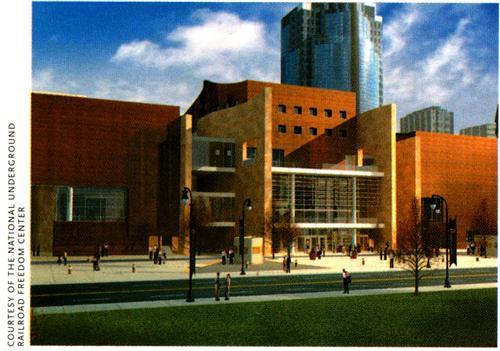Sign up for the Family Tree Newsletter Plus, you’ll receive our 10 Essential Genealogy Research Forms PDF as a special thank you!
Get Your Free Genealogy Forms
"*" indicates required fields
Cincinnati, once a pivotal stop for escaped slaves riding the Underground Railroad north to freedom, has a brand-new museum to honor that legacy: The National Underground Railroad Freedom Center <www.freedomcenter.org>, which opens Aug. 23.
Located on the banks of the Ohio River — a symbol of freedom that formed the northern boundary of the slave states — the 58,000 square-foot, $100 million Freedom Center has been under construction since June 2002. Its five galleries outline the history of slavery and the secret Underground Railroad network of conductors who hid slaves in cellars, barns, churches and haystacks until they could safely travel to the next stop along the route.
Although the center doesn’t collect artifacts of slavery, perhaps its most impressive exhibit is a large relic: a slave pen from a farm in Mason County, Ky., that warehoused slaves being sent south for sale. The pen was moved to the Freedom Center piece by piece; visitors can step inside it and see the actual beams where captives were shackled.
The National Underground Railroad Freedom Center complex comprises three connected buildings facing a park on the Ohio River.
The center’s Story Theater re-creates the Ripley, Ohio, riverfront — where Eliza crossed in Harriet Beecher Stowe’s Uncle Tom’s Cabin — down to the rocks underfoot, trees overhead and mist rising from the “river.” In a larger, 300-seat playhouse, the ceiling features a starfield showing the constellations as they appeared on Jan. 1, 1863, when President Lincoln signed the Emancipation Proclamation.
Multimedia exhibits, including newscasts and a database of human rights leaders, focus on modern freedom struggles from the US civil rights movement to the fall of the Berlin Wall. After touring the center, visitors can process what they’ve seen in a dialogue area with a discussion room, interactive videos and computer polling.
Freedom Center executive director Spencer Crew sees family history as vital to the museum’s mission. “Our goal is to make history a useful tool for navigation of the present,” he says. “Family histories allow people to better see where their stories connect to the Freedom Center experience.” That will happen at the center’s John Parker Library and Archives, a resource for scholars and family historians. The library takes its name from a slave who bought his freedom, became a successful businessman in Ripley, and rowed across the Ohio River many nights to gather runaway slaves waiting in the brush.
Church of Jesus Christ of Latter-day Saints Family History Center volunteers will assist genealogy researchers and give family history workshops at the Parker library. “We’ll provide a set of resources unique to the African-American experience and give visitors next steps for continuing their research,” says Naomi Nelson, the Freedom Center’s education director. Among those resources is a digitized archive of documents, oral histories and other literature from Underground Railroad and abolitionist collections across the country.
The Freedom Stations Web site <www.freedomcenter.org/freedomstations> gives registered users access to research, including parts of the digital library; articles on topics such as confirming your house was a station; event listings; and information on preserving Underground Railroad sites.
ADVERTISEMENT

